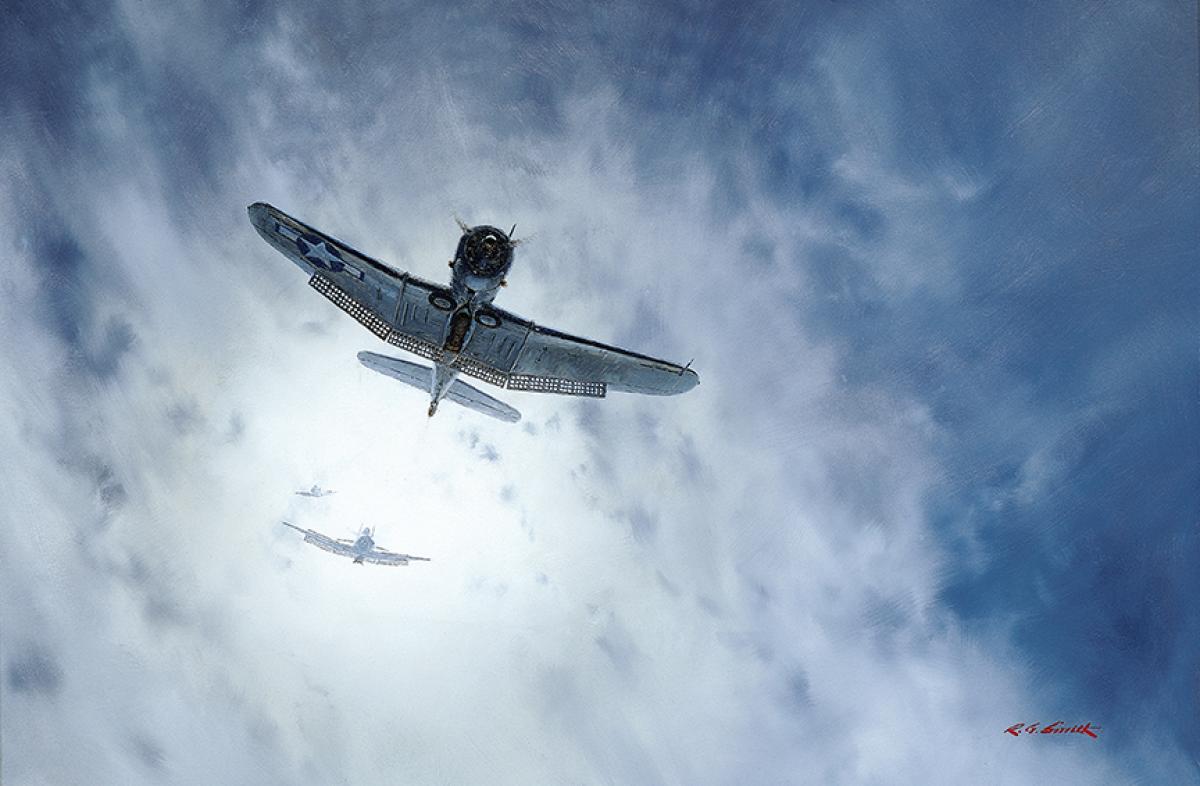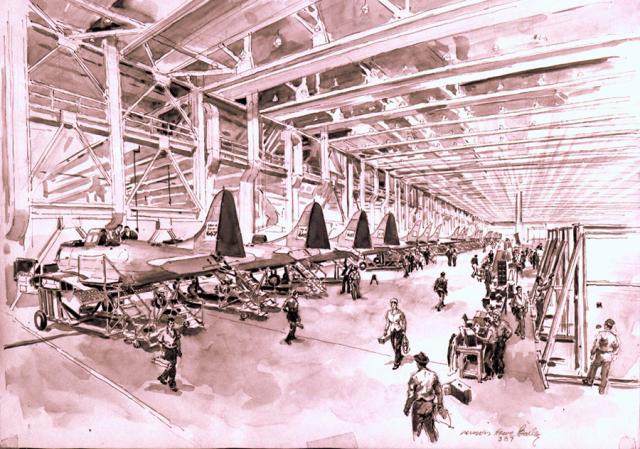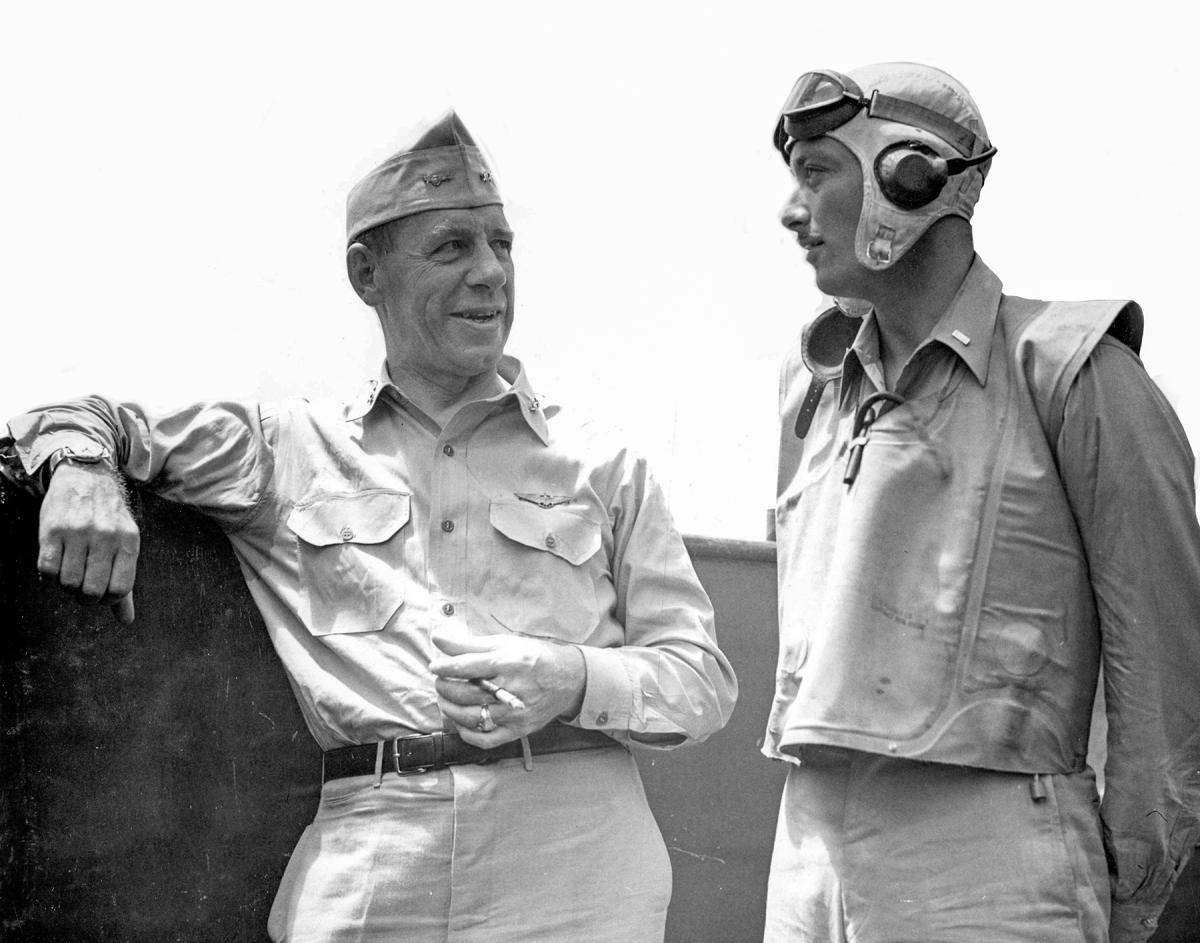Three U.S. aircraft were crucial to victory over Japan during World War II. They included the Grumman F6F Hellcat fighter, which destroyed Japanese air power while establishing air superiority over Central Pacific invasion beaches, and the Boeing B-29 Superfortress heavy bomber, which scourged the Home Islands before dropping the two bombs that forced Japan’s capitulation.
But before the Hellcat’s 1943 appearance in Pacific skies and before the Superfortress went operational in 1944, the basis of U.S. victory was established by an obsolescent carrier-based dive bomber in 1942. Officially it was the Scout Bomber by Douglas, the SBD. The American public knew the globe-trotting ship-killer as the Dauntless. When faster carrier aircraft appeared later, SBD partisans insisted the acronym meant “Slow But Deadly.” And so it was. Despite its slightly dumpy silhouette, during the 12 months after Pearl Harbor the Dauntless became the worst enemy of imperial Japan.
SBDs flying off the USS Enterprise (CV-6) initiated the Dauntless to combat on the first day of the Pacific war—7 December 1941—when 18 of them were caught by the Japanese flying into Pearl Harbor. Forty-five months later, on VJ Day, U.S. Marine Corps Dauntlesses still were flying missions in the Central Pacific, making the SBD a rare first-to-last warrior. The Dauntless fought a global war, not only in the breadth of the Pacific but also in climes as diverse as North Africa, southern Europe, and the Arctic. In all, the U.S. government purchased 5,936 of them.
Evolution of a Champion
Edward H. Heinemann was the master wingsmith at Douglas Aircraft Company. Beginning in the 1920s, he worked for various firms, starting as a draftsman, but in time he became a self-taught engineer. His intuitive grasp of aircraft design and construction led to greater responsibility, and he became Douglas’ chief engineer when the firm acquired Northrop’s El Segundo plant in 1936.
Douglas inherited Northrop’s program for a successor to the BT-1 dive bomber (B for Bomber, T for Northrop), first flown in 1935. The Navy acquired only 54 BTs, mainly for the new carriers Yorktown (CV-5) and Enterprise. The modified BT-1 was first designated BT-2, but the Navy redesignated it SBD-1 to reflect the new firm’s commitment.
The Douglas design retained the BT-1’s airfoil plus the perforated dive and landing flaps. However, the BT’s 825-hp Pratt & Whitney Twin Wasp Jr. was replaced by the 1,000-hp Wright Cyclone R-1820 in the SBD-1. Dating from 1931, the nine-cylinder, air-cooled Cyclone demonstrated considerable “stretch” in its career. Its output was boosted from the original 700 horsepower to 1,350 during World War II. Though prone to “external lubrication” (oil leaks), it was a reliable if not potent power plant. In contrast to the patented purr of Pratt and Whitneys, the “Wright rattle,” or clatter, was distinctive even from a distance. With 20 percent more power and a 36 percent increase in loaded weight, the original SBD yielded a modest improvement in top speed, though the BT cruised considerably faster.
Douglas engineers designed exceptional stability into the SBD for two reasons. First, as a carrier aircraft it needed to be solid at low airspeed in the landing pattern. Typically it stalled at about 65 knots after ample warning, usually remaining wings level. Heinemann’s crew retained the BT-1’s “letter box” slots behind each wing’s leading edge, affording the airfoil an additional opportunity to keep flying. The second reason for stability was steadiness in the dive, giving SBD pilots a stable aiming platform before releasing their bombs.
SBD production began at El Segundo in 1940, and contrary to usual procedure, the Marine Corps received the first aircraft because the “dash ones” had less internal fuel than follow-on models. Navy scout and bomber squadrons began exchanging their BTs and Curtiss SBC biplanes for SBD-2s in 1941. That October the Navy assigned names to its aircraft, often with alliterative monikers. Thus the Douglas Dauntless entered history.
Compared to level bombing, dive bombing provided vastly greater accuracy against a moving ship. As aircraft performance improved, greater loads were possible, and typically SBDs dropped 500- and 1,000-pound bombs from about 1,500 feet in 60- to 70-degree dives. The perforated flaps (with some 316 holes 2¼ inches in diameter) kept dive speed to 240 knots, or about 275 mph. Ed Heinemann’s marvelous ailerons allowed pilots to make precise corrections during a 30-second dive on a maneuvering ship.
World-Historic Influence
After Pearl Harbor, the U.S. Pacific Fleet played catch-up, relying almost entirely on carriers. Between February and May 1942, a series of hit-and-run strikes kept USS Lexington (CV-2), Saratoga (CV-3), Enterprise, and Yorktown SBD squadrons busy. Of the carriers, only “The Big E” and “Sara” survived. The Navy transferred the USS Wasp (CV-7) and Hornet (CV-8) from the Atlantic, but they were lost in September and October, respectively.
With battleships sidelined and submarines largely ineffective, 1942 was “The Year of the Dauntless.” SBDs won historic victories at Coral Sea, Midway, and Guadalcanal. While naval fighters and torpedo planes made contributions, none could match the striking power of Dauntlesses against fast, maneuvering enemy warships.
SBDs logged numerous records in the first 12 months of combat, including the first Japanese warship sunk (a submarine, I-70, on 10 December 1941) and the greater share of the first enemy carrier destroyed (the Shoho on 7 May 1942 at the Battle of the Coral Sea). In one fabled day of battle at Midway, SBDs wrecked the Imperial Japanese Navy’s striking force by destroying all four carriers committed to the Midway operation, and they added another flattop off Guadalcanal in August. Thus, the Dauntless possessed a unique ability to exert world-historic importance, determining the outcome of battles, campaigns, and the course of the war itself.
Along the way, three SBD pilots received the Medal of Honor. On 8 May at Coral Sea, the Yorktown’s Lieutenant John J. Powers kept his fatal vow “to lay one on their deck” from extreme low level. And that day Ensign William E. Hall barely survived a wave-top dogfight, defending the Lexington despite serious wounds. A month later at the Battle of Midway, Marine Captain Richard Fleming made two shipping attacks for which he would receive a posthumous Medal of Honor. The first, on 4 June, was in a Dauntless; the second, two days later, was in a Vought SB2U Vindicator scout bomber.
SBD pilots received the huge majority of attention, but they were only half the team. Seated in a swivel mount behind the pilot was the other half of the Dauntless duo: the enlisted aircrewman. Equally proficient at communications and gunnery, he had a radioman, ordnanceman, or machinist rating. Apart from transmitting vital information by Morse code, he defended the Dauntless from enemy aircraft with a flexible-mount .30-caliber machine gun—one in the first two SBD models; two in the SBD-3 onward.
The dive-bombing mission appealed to many aviators. Accuracy was paramount, as attested by experienced bomber pilot retired Commander Harold Buell: “You’re not dropping a bomb, you’re firing a shot.”
Another expert marksman, Lieutenant Commander Richard H. Best, commanded the Enterprise’s Bombing Squadron Six at Midway. In 1938 he had left the most prestigious assignment in naval aviation—Fighting Two, the famed “Flying Chiefs”—for instructing duty. Two years later he declined a return to fighters. “I saw that war was coming,” he recalled, “and I knew that fighters are defensive. I could make the best contribution in dive bombers, and I intended to be the best bomber in the Pacific Fleet.”
Thereby lies a point. In 1942 dive-bomber pilots probably were the only individual combatants who could directly affect the outcome of a battle—and possibly the war—on sea or land. Best proved it on 4 June when he flew two missions, dropped two bombs, and helped sink two carriers. On the first flight he was solely responsible for destroying the Akagi, the Japanese flagship. That afternoon he contributed to the Hiryu’s demise.
Admirers said that if dive bombing became an Olympic sport, their money would be on Dick Best for the gold. He spoke for his generation of naval aviators when he said, “Midway was revenge, sweet revenge, for Pearl Harbor.” The SBD had won a strategic victory unlike any other.
Absent the SBD, the Navy and Marine Corps would have faced an impossible situation since only the marginal SB2U “Wind Indicator”—as it was dubbed by some pilots—was available for dive bombing. That aircraft and the Douglas TBD Devastator torpedo bomber were the U.S. Navy’s first two carrier monoplanes, both reaching the fleet in late 1937. But only 260 SB2Us were built through 1941, with one-third going to France and Britain. The next-generation dive bomber, Curtiss’ bigger, faster SB2C Helldiver, came off the bench in November 1943, entering combat far too late to affect the vital events of 1942.
Fighting over the ’Canal
Midway allowed the United States to take the offensive, and Operation Watchtower, targeting Guadalcanal in the Solomon Islands, was launched on 7 August 1942. Over the next six months, Navy and Marine SBDs were essential in winning the sanguinary campaign, flying from the island’s Henderson Field and from four carriers successively supporting the Marines ashore.
As fighting raged on land, two carrier battles were fought in Solomon waters. At the Battle of the Eastern Solomons on 24 August, Enterprise and Saratoga Dauntlesses fought Coral Sea veterans Shokaku and Zuikaku, augmented by the light carrier Ryujo. Again SBDs figured prominently, being mainly responsible for sending the Ryujo to the bottom.
In October two Enterprise pilots demonstrated the SBD’s disproportionate effect. At the Battle of the Santa Cruz Islands, Lieutenant Stockton B. Strong and Ensign Charles Irvine monitored a report of enemy carriers well beyond their search sector. With flawless navigation and tactics, they penetrated the Japanese defenses, put two bombs through the Zuiho’s flight deck, and knocked her out of action for nearly two months. They got away clean—one of the finest missions ever flown from aircraft carriers. Meanwhile, land-based SBDs continually reduced Japanese naval power around Guadalcanal, ultimately forcing Tokyo to withdraw from “Starvation Island.”
In 1943 Under Secretary of the Navy James Forrestal declared, “Grumman saved Guadalcanal.” Certainly the company’s F4F Wildcat fighter played a vital role, and like the SBD/SB2U comparison, naval fighter pilots in the Henderson Field–based “Cactus Air Force” shuddered at the notion of relying on Brewster F2A Buffalos. But even including the TBF Avenger torpedo plane in the Grumman mix, Guadalcanal could not have been held without Navy and Marine SBDs.
In fact, the United States could not have waged the Guadalcanal campaign except for the Dauntless’ excellent combat performance, which kept Japanese shipping at bay during the crucial six-month struggle for the island. Nine Marine and ten Navy SBD squadrons bolstered hard-pressed defenders, ashore and afloat. Excepting patrol planes, they represented more than half of all naval combat squadrons engaged in the campaign. From May to mid-November 1942, SBDs sank four Japanese carriers and a cruiser unassisted, and shared in the destruction of two carriers, a battleship, and another cruiser with torpedo planes.
Yet the SBD paid a price for its victories. Excluding attrition in the United States, the Navy and Marine Corps lost nearly a Dauntless a day from December 1941 through 1942. The peaks were June (55) and October (72)—months that coincide with the battles of Midway and the Santa Cruz Islands.
More Battles
The SBD fought a global war beyond the Pacific. In November 1942, while the crisis peaked at Guadalcanal, Dauntlesses supported the first Allied offensive against the Western Axis. Operation Torch, the Anglo-American landings in French North Africa, involved SBDs on board the USS Ranger (CV-4) and three escort carriers. The Ranger’s Dauntlesses contributed to sinking the Vichy French battleship Jean Bart in Casablanca Harbor, though she was refloated and repaired. Eleven months later, the Ranger steamed far north, launching strikes against Axis shipping off Norway as part of Operation Leader. The carrier’s Dauntlesses and Avengers sank four steamers and a transport and damaged five other vessels.
As more squadrons arrived in the South Pacific in 1943, SBDs moved up the Solomons chain with other Allied aircraft. The lengthy aerial siege of the Japanese stronghold Rabaul, New Britain, added hundreds of sorties to the Dauntless’ combat log. So did the long, unheralded Central Pacific campaign.
The Fourth Marine Aircraft Wing perfected dive bombing against bypassed Japanese islands, continuing the action until VJ Day. And another little-known contribution occurred in the Philippines when Marine SBDs directly supported U.S. Army forces, even guarding the 1st Cavalry Division’s flank during its drive on Manila.
Though the Dauntless remained in production until July 1944 and served ashore until VJ Day, after 1943 it was increasingly replaced by the belated SB2C Helldiver. The SBD’s last carrier appearance came in the June 1944 Battle of the Philippine Sea. On the evening of 20 June, SBD-5s from the Enterprise and the new USS Lexington (CV-16) struck Japanese carriers fleeing the “Marianas Turkey Shoot” and sustained far fewer losses than Helldivers also flying the “mission beyond darkness.”
Despite missing the first 11 months of the war, the SB2C made up the deficit by serving in far more carrier squadrons than its predecessor. Carrier-based SBDs logged 5,850 “action sorties” throughout the war, only one-third of the Helldiver’s 18,800 in 1943–45, while delivering just one-fifth the ordnance. Flying from flattops, the two dive bombers recorded nearly identical loss rates in combat and overall operations. Yet the Slow But Deadly had been there when it mattered most.
Other Dauntless Users
Because the U.S. Army Air Forces (AAF) lacked a suitable dive bomber, Douglas’ Tulsa, Oklahoma, factory began producing a version of the SBD for them in 1941: the A-24 Banshee. AAF squadrons flew their bombers in the Philippines and Java, suffering heavy attrition. But eventually they recovered to use Banshees in New Guinea, the Central Pacific, and even Alaska. Including those transferred from the Navy, the AAF acquired some 950 of the dive bombers, which largely left service in 1944.
In the Pacific the only other operator was the Royal New Zealand Air Force, which obtained former Marine Corps SBDs in 1943. In the Solomon Islands, the Kiwis of No. 25 Squadron flew Dauntlesses until receiving F4U Corsairs in 1944.
French Aeronavale Dauntlesses remained in service well after VE Day, operating from the former British-built carrier Arromanches. In a chilling preview of Douglas A-1 Skyraiders, A-3 Skywarriors, and A-4 Skyhawks, the Arromanches’ SBDs launched and “trapped” in Tonkin Gulf waters from 1947 to 1949 during the First Indochina War. Some were retained as operational trainers until 1953 or after. Other postwar non-combat SBD and A-24 users included Mexico, Chile, and Morocco.
—Barrett Tillman
LCDR Richard H. Best, U.S. Navy (Ret.), interviews with author, 1972–73; 1996.
CAPT Eric M. Brown, Royal Navy (Ret.), Wings of the Navy: Flying Allied Carrier Aircraft of World War Two, second revised edition (Annapolis, MD: Naval Institute Press, 1987).
RADM Maxwell F. Leslie, U.S. Navy (Ret.), correspondence with author, 1972–73.
LtGen Richard C. Mangrum, U.S. Marine Corps (Ret.), correspondence with author, 1972–73.
Richard Prior, “Hal Buell, Pacific Pilot Flew From 4 Carriers,” The St. Augustine Record, 4 September 2006.
Col Bruce Prosser, U.S. Marine Corps (Ret.), interview with author, 1974.
Edward P. Stafford, The Big E: The Story of the USS Enterprise, illustrated edition (Annapolis, MD: Naval Institute Press, 2016).
CAPT James E. Vose Jr., U.S. Navy (Ret.), correspondence with author, 1972–73.





